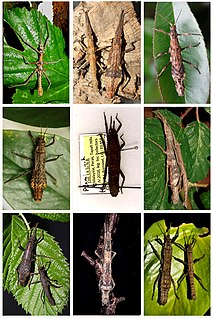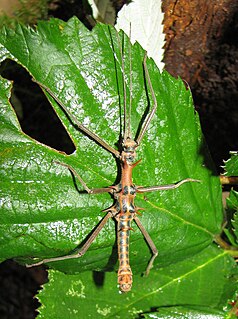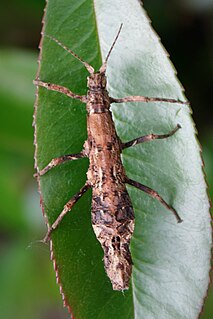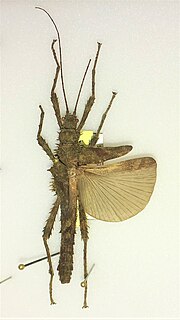
Cebrionini is a tribe of click beetles from the family Elateridae; formerly ranked as a subfamily or family, they are now considered a tribe within the subfamily Elaterinae.

Pylaemenes is a genus of stick insects in the family Heteropterygidae and subfamily Dataminae. It combines small to medium-sized, often brightly colored Phasmatodea species. Their representatives are found in large parts of Southeast Asia.
Lobofemora is a genus of stick insects in the subfamily Clitumninae. Species have known distributions from National Parks in Vietnam.

The genus Orestes combines relatively small and elongated Phasmatodea species from Southeast and East Asia.

Orestes draegeri is a species of stick insects in the subfamily Dataminae.

Datamini is the only tribe within the subfamily of the Dataminae from the order of the Phasmatodea. The representatives of this subfamily are on average not as large as those of the other two subfamilies belonging to the family of Heteropterygidae.

Epidares nolimetangere, the touch-me-not stick insect, is an insect species from the order of the Phasmatodea and the only representative of the genus Epidares. The species name nolimetangere comes from Latin and means "don't touch me". It refers to the prickly appearance of the animals.

The genus Dares, which is mainly native to Borneo, combines relatively small and mostly dark-colored Phasmatodea species.

The genus Microrestes combines relatively small and squat Phasmatodea species from continental Southeast Asia and South China.

Hoploclonia is the only genus of the tribe Hoplocloniini and brings together relatively small and darkly colored Phasmatodea species.

Orestes dittmari is a species of stick insects in the subfamily Dataminae.

Miroceramia is a monotypic genus of stick insects, containing Miroceramia westwoodii as the only described species. It is the only fully winged one of the subfamily Obriminae.

Orestes bachmaensis is a Phasmatodea species native to central Vietnam.

Orestes japonicus, a stick insect, is a representative of the genus Orestes.

Orestes krijnsi is a species of stick insects native to Vietnam.

Orestes subcylindricus is a species of stick insects native to Vietnam.

Orestes shirakii is a species of stick insects native to Taiwan.

Pylaemenes elenamikhailorum is a species of stick insects native in Sepilok on Borneo. In application of the more recent differentiation between the genera Pylaemenes and Orestes the species is sometimes also called Orestes elenamikhailorum.
Pylaemenes konkakinhensis is a species of stick insects native in Vietnam. The species is so far only known from a single female.
Orestes botot is a species of stick insects native in Vietnam.
















